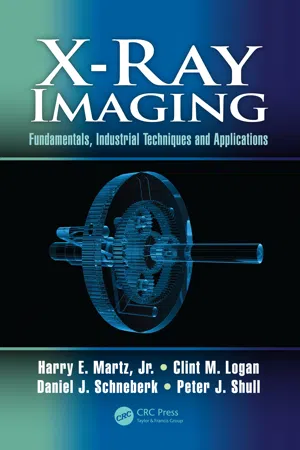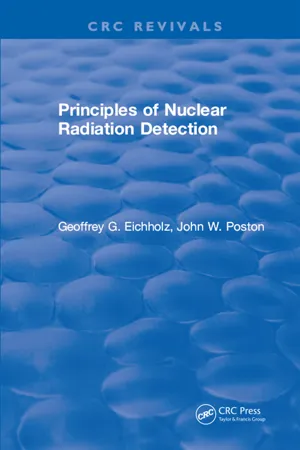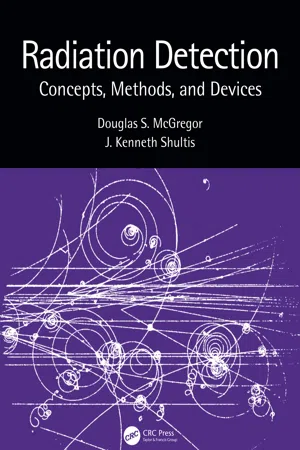Physics
High Energy X-Rays
High energy X-rays are a type of electromagnetic radiation with wavelengths shorter than those of visible light. They are produced by accelerating charged particles, such as electrons, to high speeds and then suddenly decelerating them. High energy X-rays are used in various applications, including medical imaging, industrial inspection, and scientific research due to their ability to penetrate materials and provide detailed information about their internal structure.
Written by Perlego with AI-assistance
Related key terms
Related key terms
1 of 4
Related key terms
1 of 3
6 Key excerpts on "High Energy X-Rays"
- eBook - ePub
Ionizing Radiation Technologies
Managing and Extracting Value from Wastes
- Shima Shayanfar, Suresh D. Pillai, Shima Shayanfar, Suresh D. Pillai(Authors)
- 2022(Publication Date)
- Wiley-Blackwell(Publisher)
3 X-ray TechnologyJeremy Brison, Rick Galloway, Christophe Malice, and Josef Mittendorfer3.1 Introduction to X-ray Technology
3.1.1 What are X-rays?
X-rays are an essential high-energy form of electromagnetic waves and therefore part of the electromagnetic spectrum like radio signals or visible light. The only difference is the shorter wavelength of X-rays. While visible red light has a wavelength of 700 nanometers, X-rays start around 10 nanometers and go down below 1 picometer. The higher the energy, the lower the wavelength. Low-energy X-rays begin with an energy of around 100 electron volts—the energy unit used in atomic physics—going up to several million electron volts (MeV) for high-energy X-rays.X-rays are a form of ionizing radiation interacting with matter they pass and transferring energy to the electrons of the atoms. Due to their energy X-rays are capable of knocking off electrons from atoms, leaving positive ions and free electrons.3.1.2 A Brief History
The discovery of X-rays is a remarkable chapter in the history of science, involving several researchers over a period of time. In experiments with gas discharge tubes, involving so called cathode rays at that time, an unassigned glow outside the tube structure was observed. The discovery of X-rays is generally attributed to Wilhelm Conrad Roentgen, who systematically studied the luminescence effect and published it in December 1895. Due to the unknown character of the new form of radiation he called it X-rays. Roentgen received a Nobel Prize in 1901, and was the first Nobel laureate in physics.3.1.3 Comparison to Other Forms of Radiation
Ionizing radiation is named for its capability of producing ions from neutral atoms. It can be grouped into two categories: radiation from natural or artificially produced isotopes and from machine sources. The first category is historically divided into three groups, two of which (alpha and beta rays) involve charged particles. Gamma rays emitted in isotope decay are electromagnetic waves and therefore uncharged. Ionizing radiation from machine sources is primarily electrons produced in accelerators. - eBook - ePub
X-Ray Imaging
Fundamentals, Industrial Techniques and Applications
- Harry E. Martz, Clint M. Logan, Daniel J. Schneberk, Peter J. Shull(Authors)
- 2016(Publication Date)
- CRC Press(Publisher)
4 Physics of X-Ray and γ-Ray Sources4.1INTRODUCTION
In this chapter, you will be introduced to the physics of high-energy photon sources. In this text, high-energy photons mean electromagnetic radiation that is higher in energy than other more common electromagnetic radiation such as visible and ultraviolet photons (see Figure 4.1 ). Depending on their origin, these photons may be x-rays, gamma-rays (often denoted by the Greek letter gamma, γ), or annihilation radiation.Upon completion of this chapter, you will be able to understand the following:- Types and sources of high-energy photons
- Generation of x-rays by electrons
–Bremsstrahlung (braking or decelerating electrons) –Characteristic x-rays –Accelerating charge
- Where γ-rays come from
- Source of annihilation radiation
- Units used to characterize and describe high-energy photons
- Generation of x-rays by electrons
4.2TYPES OF HIGH-ENERGY PHOTONS: X, γ, AND ANNIHILATION RADIATION
Radiation of an unknown type and origin was discovered in the year 1895 by Wilhelm Röntgen. They were dubbed x-rays by their discoverer, while in his honor, some referred to them as Röntgen rays. They were soon found to be a form of electromagnetic radiation with extremely short wavelengths (very high energy). X, γ, and annihilation radiation are called ionizing because their interactions with matter can eject electrons* from an atom,† creating a positively charged ion. Here we provide the physics of how x-rays, γ-rays, and annihilation radiation are produced and how they differ in definition only. X-rays are a highly energetic form of electromagnetic radiation generated by accelerated or decelerated electrons or atomic energy (i.e., electronic) transitions. They have extremely short wavelengths (6.0 × 10−12 m to 1.5 × 10−8 m); most are smaller than the size of an atom (~10−10 m). γ-rays are an energetic form of electromagnetic radiation produced by nuclear energy (neutron or proton) transitions, typically by radioactive decay. Annihilation radiation is electromagnetic radiation produced when a positron* (β+ ) and electron (β− - eBook - ePub
- Geoffrey G. Eichholz(Author)
- 2018(Publication Date)
- CRC Press(Publisher)
The now-vacant state can then be filled by the transfer of an electron from a higher electron shell, accompanied by emission of the energy difference in the form of electromagnetic radiation. In this case, this energy difference is of the order of kiloelectron-volts (keV) and the photons are in the X-ray portion of the spectrum and considerably more penetrating. The precise X-ray energy emitted again is characteristic of the atom involved; since it involves a lower, tightly bound energy level, it is unaffected by the chemical state of the atom. Different X-ray energies can be emitted corresponding to different identifiable transfer possibilities between the various shells and their sublevels involved and the final destination level. Accordingly, one distinguishes K α,β,γ, L α,β,γ, M α,β,γ, etc., X-rays for each atom. In some cases the major energy jump giving rise to emission may be preceded by some energy re-arrangement within the higher level, giving rise to two-stage transfers or some competitive transfer routes with several X-rays of varying intensity. This is called an Auger process. If the emission of characteristic X-rays of predetermined energy is the result of the absorption of higher-energy X-rays of perhaps less well-defined energy, then this is referred to as X-ray fluorescence. When a heavy charged particle is stopped in a medium by losing its energy to the target atoms by electron excitation, the prompt X-ray emission that accompanies the return of the excited electrons to the normal levels is called bremsstrahlung (German for “braking radiation”). In the case of bulk insulators and semiconductors, the scheme of potential energy levels for the electrons is not continuous from the occupied levels to the highest excited states. Instead there is a region, referred to as the “forbidden gap,” where no stable electron states are normally found. The region where electrons normally occupy energy levels is called the valence band - eBook - ePub
- Jeff C. Bryan(Author)
- 2018(Publication Date)
- CRC Press(Publisher)
13 X-ray ProductionX-rays are used extensively in diagnostic and therapeutic medical applications. This chapter starts by looking at how X-rays are generated for diagnostic applications, such as those performed in hospitals and dentist offices, and then moves into how high-energy X-ray beams are produced for radiation therapy. Interestingly enough, knowledge of how electrons interact with matter (Section 6.2 ) is key to understanding how X-rays come about.13.1Conventional X-ray BeamsFor diagnostic medical applications, such as an X-ray of your foot to see if any bones are broken, we’d like to consistently produce high-energy photons on demand—a flip of the switch to provide the same energy and intensity every time would be great. It is also desirable for our photon generator to be safe and affordable. The only source that satisfies all these requirements is a particle accelerator. A conventional X-ray tube is a small particle accelerator (Section 9.4 ). Let’s see how it works.A schematic of a typical conventional X-ray tube is shown in Figure 13.1 . The filament is a tungsten wire, much like those used in (old-school) incandescent light bulbs. If we run a little electric current through the filament at a high enough voltage, we can get electrons to boil off the wire. The filament is, therefore, a cathode.Figure 13.1 Schematic of a conventional X-ray tube.After they jump off the cathode, the electrons are accelerated toward the positively charged anode (target). The maximum energy they attain will be equal to the potential difference (tube voltage) between the two electrodes. For all this to happen, both electrodes need to be under vacuum, so the whole X-ray tube is enclosed and pumped out. This is important because the electrodes would rapidly corrode if exposed to oxygen and because the electrons could interact with any matter (gases) on their way from the filament to the target.Electrons won’t boil off the cathode unless the filament is pretty hot. The current of electrons flowing through the wire (filament current ) does this—just like a toaster! Since it will get hot, it’s important to make the filament out of a metal with a high melting point. Tungsten melts higher than any other metal (3370°C), so it works quite well. The filament current is usually set at a few amps. The other current flowing in the tube is made up of the (relatively few) electrons moving from the cathode (filament) to the anode (target). This is called the tube current - eBook - ePub
Methods and Applications of Statistics in Clinical Trials, Volume 2
Planning, Analysis, and Inferential Methods
- Narayanaswamy Balakrishnan, N. Balakrishnan(Authors)
- 2014(Publication Date)
- Wiley(Publisher)
Figure 9b . Only a few photons are emitted with the full 100 keV of energy of the incident electrons, and the vast majority are radiated away with far less.The measured spectrum for a real X-ray tube differs from this straight-line, curve B, For reasons soon to be discussed, the rate of X-ray absorption by materials in creases rapidly the lower their energy. This means that as newly minted X rays emerge from (sometimes deep) within the target itself, pass through the glass window of the X-ray tube, and even through intentionally placed filters (usually aluminum), C, the lower-energy ones are preferentially removed. This is good, because these low- energy X rays do not penetrate far through tissues, and therefore cannot contribute to image formation, but they will deposit dose, and there is a very slight chance that this will lead to adverse health effects. The most energetic characteristic X rays photons for tungsten, incidentally, lie in the range from 58 to 69 keV.The X rays emerging from a tube pass through an adjustable beam collimator (Figure 7 ), again. The result of all this is that a nearly uniform, rectangular beam of X rays of appropriate dimensions exits the tube via its window and heads off toward, say, a patient’s hand.14.2.3 Exponential Attenuation of a Narrow Monochromatic Beam by a Homogeneous Medium
Electromagnetic radiation can interact with matter by various mechanisms. The relative probability that a photon will collide with an atomic electron depends on the energy of the photons and on the nature of the material; physicists have expended much of their efforts over the past century in learning about those processes.The attenuation of a narrow X-ray beam in passing through soft tissues, bone, or IR materials, in particular, is easily studied by experiment (Figure 10a ). The intensity of the beam, I(x) (the amount of X-ray energy passing through a unit area per second), is monitored as different thicknesses, x, of the attenuating material are inserted into the beam path. I(0) is the intensity when there is no attenuating material in its path, x - eBook - ePub
Radiation Detection
Concepts, Methods, and Devices
- Douglas McGregor, J. Kenneth Shultis(Authors)
- 2020(Publication Date)
- CRC Press(Publisher)
Today the development of ever more energetic particle accelerators is driven by the high energy physics community. With these enormous and costly machines, physicists will perform experiments that will reveal information about the fundamental physics governing the subatomic world. Accelerators with lower energies are also central to other areas of research such as the study of atomic and nuclear physics. A 1-GeV proton accelerator is now used at the Spallation Neutron Source at Oak Ridge National Laboratory to bombard a liquid mercury target. The resulting spallation reactions release copious neutrons which are ideal probes to determine molecular structures. Accelerators can also be used to produce intense x-ray beams that in turn can be used in fundamental research on materials. As in most areas of fundamental research, accelerator technology has spun off many practical applications such as cancer therapy, production of important radionuclides, ion implanting, and food preservation to name a few.For high energy physics research, special radiation detectors are needed to detect the myriad of subatomic particles that are produced in these machines. Such detectors are huge, very expensive, and usually one of a kind. Consequently, only brief consideration of such detectors is given in this book.5.6Cosmic RaysAt the beginning of the twentieth century, the reason why electrometers would discharge for no apparent reason was a mystery. One postulated explanation was that earth itself emitted ubiquitous ionizing radiation. But in 1911 Victor Hess, using electrometers on a balloon, found that ionizing radiation increased in strength with altitude, thereby showing that this radiation came from outer space.Although much is now known about this cosmic radiation, there are many aspects of it that are still mysterious. Cosmic radiation has been measured from a few GeV to over 1020 eV. At a few GeVs the composition is 98% nuclei (of which 87% are protons, 12% helium nuclei, and 1% heavier nuclei), <2% electrons, and <10−4 % gamma rays. One unsettled question is how the most energetic cosmic rays are produced. For example, since 1991 more that 20 protons with energies ≥ 3 × 1020 eV have been observed. This energy corresponds to 48 J, which is the kinetic energy of a 58-g tennis ball moving at about 150 km/h! The energy spectrum of cosmic rays follows a “power law” E−αwhere α ≃ 2.7 for 1010 < E < 3 × 1015 eV and, above 3 × 1015 eV, α
Index pages curate the most relevant extracts from our library of academic textbooks. They’ve been created using an in-house natural language model (NLM), each adding context and meaning to key research topics.
Explore more topic indexes
Explore more topic indexes
1 of 6
Explore more topic indexes
1 of 4





